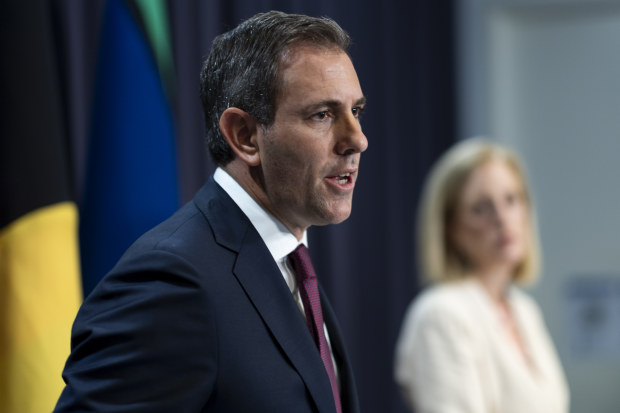The AFR View

MYEFO’s missing medium-term fiscal framework
Governments once were politically rewarded for keeping a tight lid on the size and cost of government.
EY chief economist Cherelle Murphy’s graph showing the sharp spike in all levels of public expenditure as a proportion of GDP in the past decade suggests that post-pandemic Australia is becoming a permanently higher taxing country with a structurally higher level of government spending. No wonder productivity is actually falling.

Treasurer Jim Chalmers discusses the budget update in Canberra on Wednesday. AFR
Jim Chalmers’ Mid-Year Economic and Fiscal Outlook points to federal government tax and other revenue consuming a record 26 per cent of national income in a decade. Even by then, the tax grab will fall short of rising public spending. Since the political failure of the Abbott government’s 2014 budget that aborted then-treasurer Joe Hockey’s mission to end the “age of entitlement”, there has been a bipartisan failure to discipline the community’s expectations of what governments can deliver even for worthy causes. Those expectations were further unmoored during the pandemic as governments borrowed massive sums of what was then ultra-cheap money to provide social protection all around.
This helped spur Labor’s “care economy” election spending promises in aged care and childcare. Labor now has promised to cap growth in the cost of the out-of-control National Disability Insurance Scheme monster at 8 per cent. But this has had to be “bought” by committing billions of dollars to new support services for childhood conditions, to “no worse off” GST top-up payments and more public hospital funding. And there is now a renewed push for even more spending on schools after the billions of dollars of Gonksi “education revolution” funding failed to reverse declining student performance, as the productivity of the school system actually fell.
Governments once were politically rewarded for keeping a tight lid on the size of government, the taxes needed to fund it and the shortfall needed to be financed by borrowing. In the 1980s, the Hawke-Keating Labor government set clear budget rules for all three. In 1996, the Howard government established the Charter of Budget Honesty which formalised a medium-term framework of balanced budgets over the economic cycle. This framework, which helped anchor budget expectations and insulate the public finances of this commodity-exporting nation against global volatility, was jettisoned by the Morrison government at the start of the pandemic. It was replaced by the very modest goal of shrinking the debt as a share of GDP over time, and has not been restored by the Albanese government.
Nor has Labor committed to abiding by the Coalition’s 23.9 per cent tax-to-GDP cap to help discipline spending. At this point in the cycle, the budget should be running a string of substantial budget surpluses given that tax revenue is being pumped up by resource company profits fuelled by record higher iron ore, coal and gas prices and by personal income taxes pouring in from a fully employed labour force pumped up by the overdone pandemic fiscal and monetary stimulus showered on households. A string of multi-year surpluses is needed to build back the budget buffers amid the greater risk of external shocks from more geopolitically dangerous times. This will require much more spending discipline given the pressure to accommodate rising defence obligations.
Since the May budget, forecast tax revenues over the next four years have increased by $64 billion as bracket creep and strong economic growth have pushed up personal income tax and higher commodity prices have inflated company taxes. Yet the forecast improvement to the budget bottom line has been limited to $40 billion even after the deferral of infrastructure projects that might not have been done anyway. Resisting political pressures to spend all the revenue windfall is good as far as it goes to avoid throwing even more of the inflation-fighting burden on to the Reserve Bank. But the central bank’s medium-term low inflation framework needs to be mirrored by a comparable medium-term framework for fiscal policy.
The Treasurer’s welcome indication that the government will not seek to overturn the Morrison government’s stage 3 tax cuts legislated from July should provide the political prompt to formally commit Labor to at least start on re-anchoring budget expectations and avoiding Australia becoming a higher spending, higher taxing and lower growth country.
Introducing your Newsfeed
Follow the topics, people and companies that matter to you.
Find out moreRead More
Latest In Economy
Fetching latest articles